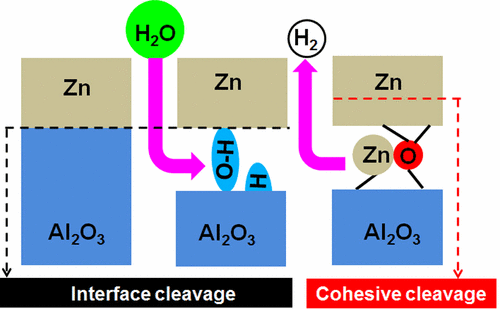当前位置:
X-MOL 学术
›
J. Phys. Chem. C
›
论文详情
Our official English website, www.x-mol.net, welcomes your
feedback! (Note: you will need to create a separate account there.)
Tuning Adhesion at Metal/Oxide Interfaces by Surface Hydroxylation
The Journal of Physical Chemistry C ( IF 3.3 ) Pub Date : 2017-05-04 00:00:00 , DOI: 10.1021/acs.jpcc.7b02456
Ha-Linh Thi Le 1, 2, 3 , Rémi Lazzari 1, 2 , Jacek Goniakowski 1, 2 , Rémi Cavallotti 1, 2, 3 , Stéphane Chenot 1, 2 , Claudine Noguera 1, 2 , Jacques Jupille 1, 2 , Alexey Koltsov 3 , Jean-Michel Mataigne 3
The Journal of Physical Chemistry C ( IF 3.3 ) Pub Date : 2017-05-04 00:00:00 , DOI: 10.1021/acs.jpcc.7b02456
Ha-Linh Thi Le 1, 2, 3 , Rémi Lazzari 1, 2 , Jacek Goniakowski 1, 2 , Rémi Cavallotti 1, 2, 3 , Stéphane Chenot 1, 2 , Claudine Noguera 1, 2 , Jacques Jupille 1, 2 , Alexey Koltsov 3 , Jean-Michel Mataigne 3
Affiliation

|
–The control of adhesion at metal/oxide interfaces is of key importance in modern applications, whenever three-dimensional metal clusters or two-dimensional metal overlayers are to be synthesized on an oxide support. By focusing on the zinc/alumina system, we address here one of the long-standing issues in this context, which is the poor wetting of wide band gap oxides by noble and post-transition metals. It has recently been recognized to have detrimental industrial consequences for the adhesion of anticorrosive zinc coatings to new high strength steel grades. We have combined photoemission, thermal desorption, and plasmonics with atomistic simulation to describe the energetics of zinc deposits on dry and hydroxylated α-Al2O3(0001) surfaces. Both experimental and computational results show that an activated reaction of the metal with the OH-covered surface, followed by hydrogen desorption, produces dispersed interfacial moieties involving both oxidized Zn species and under-coordinated oxygen ions that lead to a significant improvement of adsorption/adhesion characteristics on the hydroxylated surface. In particular, the key role of interfacial under-coordinated anions, remnants of the hydroxylation layer, is highlighted for the first time, pointing to a general mechanism by which surface hydroxylation appears as a promising route toward a systematic improvement of wide band gap oxide wetting by metals.
中文翻译:

通过表面羟基化作用调节金属/氧化物界面处的粘附力
–在现代应用中,每当要在氧化物载体上合成三维金属簇或二维金属覆盖层时,控制金属/氧化物界面的附着力至关重要。通过关注锌/氧化铝系统,在此我们解决了这一长期存在的问题之一,那就是贵金属和过渡后金属对宽带隙氧化物的不良润湿性。最近已经认识到,防腐锌涂层与新的高强度钢种之间的粘合具有有害的工业后果。我们结合光电发射,热解吸,并与等离子体原子模拟来描述干和羟基化的锌沉积物的能量学的α-Al 2 ö 3(0001)表面。实验和计算结果均表明,金属与被OH覆盖的表面发生了活化反应,然后发生氢解吸,产生了分散的界面部分,其中涉及氧化的Zn物种和配位不足的氧离子,这导致吸附/附着力的显着改善。羟基化表面的特性。特别是,首次强调了界面配位不足的阴离子(羟基化层的残余物)的关键作用,指出了表面羟基化似乎是系统改善宽带隙氧化物氧化物润湿的有前途的途径的一般机制。通过金属。
更新日期:2017-05-17
中文翻译:

通过表面羟基化作用调节金属/氧化物界面处的粘附力
–在现代应用中,每当要在氧化物载体上合成三维金属簇或二维金属覆盖层时,控制金属/氧化物界面的附着力至关重要。通过关注锌/氧化铝系统,在此我们解决了这一长期存在的问题之一,那就是贵金属和过渡后金属对宽带隙氧化物的不良润湿性。最近已经认识到,防腐锌涂层与新的高强度钢种之间的粘合具有有害的工业后果。我们结合光电发射,热解吸,并与等离子体原子模拟来描述干和羟基化的锌沉积物的能量学的α-Al 2 ö 3(0001)表面。实验和计算结果均表明,金属与被OH覆盖的表面发生了活化反应,然后发生氢解吸,产生了分散的界面部分,其中涉及氧化的Zn物种和配位不足的氧离子,这导致吸附/附着力的显着改善。羟基化表面的特性。特别是,首次强调了界面配位不足的阴离子(羟基化层的残余物)的关键作用,指出了表面羟基化似乎是系统改善宽带隙氧化物氧化物润湿的有前途的途径的一般机制。通过金属。







































 京公网安备 11010802027423号
京公网安备 11010802027423号